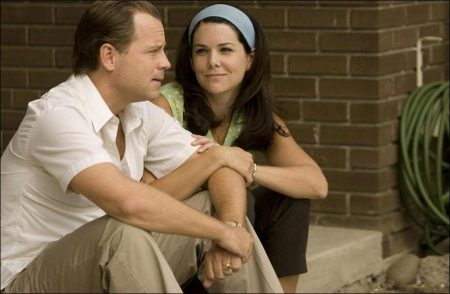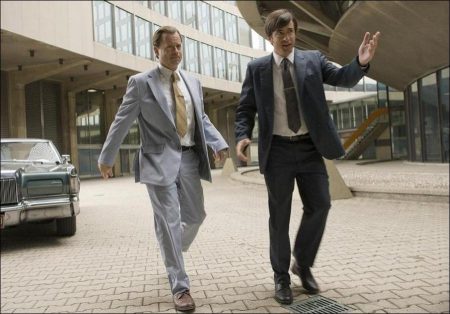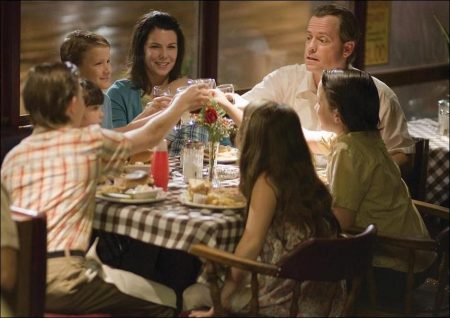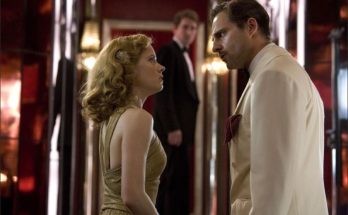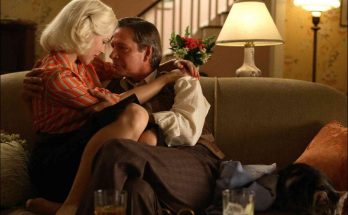The Kearns were a typical 1960s Detroit family, trying to live their version of the American Dream. Local college professor Bob (Greg Kinnear) married schoolteacher Phyllis (Lauren Graham) and, by their mid-thirties, had six kids who brought them a hectic but satisfying Midwestern existence.
When inveterate tinkerer Bob invents the intermittent windshield wiper-a device that would eventually be used by every car in the world-he is not only proud and thrilled, but the Kearns think they have struck gold. Working with family friend Gil Previck (Dermot Mulroney), they develop the revolutionary product and take it to market. But their aspirations are dashed after the automotive giants who embraced Bob’s device unceremoniously take his creation and shun the man who imagined it.
Ignored, threatened and then buried in years of litigation, Bob is haunted by what was done to his family and their future. He turns to attorneys, including Gregory Lawson (Alan Alda), to help him fight the seemingly impossible battle…but their approach and willingness to settle leaves Bob with the realization he alone must pursue the justice he needs. He becomes a man obsessed. His conviction is simple: his life’s work-or for that matter, anyone’s work- should be acknowledged by those who stand to benefit. And while paying the toll for refusing to compromise his dignity, this everyday David will try the unthinkable: to bring Goliath to his knees.
Before The Production
“His remarkable success has made him one of the most famous inventors in the country, a hero to thousands of inventors with their own patent-infringement horror stories to tell.” -John Seabrook, The New Yorker, 1993
The phrase “flash of genius” refers to a 1941 U.S. Supreme Court decision, which states that in order for his or her creation to qualify as an invention, the inventor “must reveal the flash of creative genius, not merely the skill of the calling,” that inspired said product. How to define the word “invention,” however, has been an ongoing conundrum, and the answer is still vague at best. In the early days of the court’s decision, a person’s invention was more protected and considered sacrosanct. As the power and influence of corporations grew, the nature of that protection shifted to favor capitalist advancement.
The ’60s was the golden era of the American automobile industry, and Detroit was at the booming heart of it. Dr. Robert Kearns worked as an engineering professor at Wayne State University in the Motor City in the late ’60s and, in his off hours, was a tenacious inventor in his basement workshop. Having damaged his eye in an accident with an errant champagne cork on the evening of his wedding, Kearns was fascinated and inspired by the adaptability of the human body. He grew curious to know if a windshield wiper could be designed to work just like a blinking eye, drawing across the car’s glass with intermittent timing, depending upon the needs of the driver in inclement weather- from a smattering of raindrops to a more consistent downpour.
After many failed tries, the engineer invented a windshield wiper that worked perfectly. He had created a solution to imperfect standard wipers: the intermittent windshield wiper outfitted with “The Kearns Blinking Eye Motor.” While his creation used three common electrical components that had long been used-a capacitor, resistor and transistor-he put them together in a manner that no one had done before and no one has done better since. His flash of genius had given birth to a superior safety device that would be installed in millions of automobiles worldwide.
Though he and a family friend who worked as an auto parts supplier secured the patent for his “Blinking Eye,” Kearns did not know that the Big Three automobile manufacturers had been working on the same idea. However, they had not cracked the problem yet. Kearns went to juggernaut automotive manufacturer Ford with his invention, but after a brief stint as a consultant, he was told Ford was no longer interested in the project and his assistance was no longer required.
A couple of years passed before the engineer began seeing new cars on the road that, to his astonishment, were using the very intermittent windshield wiper he had designed. After he took one apart, he discovered that it was the invention he’d brought to Ford. The company claimed it had already been working on the idea and didn’t need to use his patent to manufacture and install the wiper into its line of cars. Kearns knew they were not telling the truth.
Once he understood the gravity of the task at hand (and the fact that few attorneys were interested in a seemingly impossible and possibly endless battle), Kearns enlisted his children and wife to help with his fight. But the deeper his obsession became, the more he put his family at risk. His wife Phyllis gave it everything she had-on top of raising their six kids-but her dedication wasn’t enough. She finally left him. Mrs. Kearns recalls of her decision: “It was like he had a drug problem-that obsession was so strong. I said to him one day, `Bob, I don’t know if I can take anymore of this. This is killing me.’ And he said, `This is no way to live a life, and without the lawsuit, there’s no life.’ I realized how deep he was in it and the fact that he was losing his patent to these guys because they plucked it away from him.”
Much of the younger Kearns’ childhoods-and, for that matter, lives-were spent studying legal papers, researching patent law and scrutinizing jurors. At one point or another, five of the six kids were employed by their father to assist in the quest. Eldest son Dennis explains: “It was gradual over many years; stepping a little further out until suddenly we realized we were in quicksand up to our necks, and we were alone.”
Though the designer had initially hired expensive lawyers to try his case, when Ford came back with settlement offers in the multiple millions, he turned them down. The fiery professor with an everyman sensibility was committed to receiving credit for his invention and receiving an apology from the company that took away his dream of manufacturing the “Blinking Eye” with his family. Kearns was no longer just an inventor who had a brilliant idea. His focus changed to crusader against injustice.
His story, despite the fact that he did what no one before him could have, is a tale of the price of victory. His persistence was the source of both his success and his undoing. It was never about personal gain for Dr. Robert Kearns; it was about fighting exploitation by those with more money and power. He fought to the end with enormous personal cost to his family, career and sanity. In the end, the jury found that Ford did infringe patents held by Kearns and awarded him more than $10 million. Three years later, he was awarded $18.7 million from the Chrysler Corporation.
When this case first went to court, the most Ford had ever paid anyone for a patent was 11 cents per unit. Toward the end of the family’s lawsuit, inventors were slapping Kearns on the back because they were receiving an unheard of two dollars per unit. Not to mention the fact that, today, the auto industry still uses Kearns’ “Blinking Eye Motor” mechanism for the windshield wipers installed in most cars. To this day, nothing works better.
About the Production
Robert Kearns’ lengthy travails with automotive giants and patent law were chronicled in John Seabrook’s 1993 article for The New Yorker titled “Flash of Genius.” Producer Michael Lieber was fascinated by the story, optioned Seabrook’s article and brought screenwriter Philip Railsback onto the project to craft the script. In 1998, they approached veteran producer Marc Abraham.
Abraham remembers that he was touched by the family’s plight: “I read the article John wrote. I just loved everything about it-the American Dream, the experience, the disappointment, the fact that Bob was a professor. I was a producer at the time, but I said to Mike, Phil and John, `Just so you know, I’m planning on directing this movie. I don’t know when and I don’t know under what circumstances, but I’m going to direct it.’ And, in the end, that’s what actually happened.”
The director saw all the elements of a film with which he would make his directorial debut in Flash of Genius. “Marc’s eyes lit up,” recounts Lieber. “Here was a family man living the American Dream who risked everything to go up against the big system for a principle he believed in. The most amazing thing about Kearns is that he was not particularly interested in money. He wanted justice.”
Throughout the next decade, the project would gel as Abraham continued to produce critical and commercial successes-from Spy Game, starring Brad Pitt and Robert Redford, and the surprise hit teen comedy Bring It On to the reimagined Dawn of the Dead and director Alfonso Cuarón’s dystopic vision of a near future, Children of Men. When the time was right, Abraham secured Spyglass Entertainment’s Roger Birnbaum and Gary Barber as fellow producers for the film, and Abraham stepped into the director’s role.
Unbeknownst to the producers, Dr. Kearns had turned down several other offers from Hollywood. It took some time for him and his relatives to trust anyone with the story of their lives. Eventually, the director and his team won the Kearns over with their passion for the project and promise to honor the family’s story by keeping the film as close to the truth as possible. The drama they wanted to make would be easier to hew quite close to actual events, as the Kearns family provided documentation, home movies, photographs and anecdotal information about the landmark case. Oldest son Dennis Kearns represented his mother and siblings, and he worked with Marc Abraham and crew for nine years while the project was finalized.
Of taking a chance on a new director, producer Barber explains, “We had tremendous confidence in Marc because he had all the makings of a great director going in. He’s well versed in all aspects of filmmaking; he’s well organized, articulate and has time for all of the actors and crew. We also knew he would assemble the right team to tell this authentic underdog story.”
Producer Birnbaum agrees with Barber’s assessment: “I knew Marc as an experienced filmmaker who knows how to tell a story. He produces, he writes, he loves making movies. Marc thought this project would be a great choice for his first turn as a director because of the roller-coaster ride Kearns took for so many years. The oddness of the invention, and the iconic nature of the automotive industry in the `60s and `70s all wove together to make a great story.”
With the principal filmmakers set and the Kearns family’s blessing secured, the production would begin selecting the cast of friends and foes who would make Flash of Genius a reality.
Casting the Film
It was paramount when casting the role of Robert Kearns for Flash of Genius that audiences would believe this is a well-intentioned man who cherishes his family, but loses himself in an unimaginable lawsuit. We want to like him; we want to believe in and root for him even during the times he becomes unlikable. Enter actor Greg Kinnear. “Refreshing and inspiring” are the words Kinnear uses to describe his draw to the story. “The richness of character and the integrity of what Kearns was fighting for-not the money, but his dignity and what was right. That kind of purity is rare.”
Director Abraham’s solid track record as a producer inspired the confidence in the performer it would take to film the part. Kinnear continues: “Marc’s deeply passionate about this story on both personal and cinematic levels, and he stuck to it and fought for it and found the truth of it.”
To prepare for the role, Kinnear researched the Kearns’ family story and began to assemble a portrait of the complex inventor and his family. He immersed himself in articles about the case and studied the family’s home movies and an appearance by the inventor on David Letterman’s late night show that captured the essence of the engineer.
The performer was keen to not simply paint Kearns as an infallible hero, but a father and a husband who made some very difficult decisions on behalf of his family, some of which devastated them. “This was a story worth telling, a fight ultimately worth fighting,” he notes. “Even if you were watching him go through this, there are moments where you want to stand up and say, `Bob, snap out of it!’ But he goes through this battle, and you ultimately respect him for it.”
Of Kinnear’s appeal and why he felt he was the right fit for the project, Abraham surmises: “Greg allows himself to go to certain extremes that a lot of actors are afraid to. He’s comfortable taking risks and playing both the greatest guy in the world, as well as a guy who may have crossed a line. This makes him attractive as an actor and empathetic to an audience. He gave every last ounce of blood and talent to the role, and we were so in sync about what we admire and appreciate about Bob.”
Lauren Graham was cast as Phyllis Kearns, the long-suffering teacher and Kearns family matriarch who watches as her husband’s obsession with legal retribution pulls their family apart. Of his decision to work with Graham, Abraham reflects: “Phyllis’ character is critical, and we needed an actress who the audience could relate to and therefore understand the choice she makes at a time in history when it was more difficult. She also had to have the bearing and willingness to completely invest in a character who has six children. Lauren’s a really smart, well-trained and committed actress who had the skill and talent to manage all of these elements beautifully.”
The actor offers why she was intrigued to portray a woman who struggled so much, and she offers the counterpoint that many in the Kearns family felt as they were in the midst of hell: “There are pieces of this movie that I feel could be about almost any addiction. What starts as his belief that he’s fighting for what’s right turns into an obsession with getting everyone to say, `This was yours; we stole it from you, and we were wrong.’
“It’s a classic David and Goliath story,” continues Graham, “man against the machine. Rather than see the big picture and understand he may not get everything he wants, there’s no room for compromise for him. What begins as something that the family is behind, that they’re a team in, turns into his singular obsession-a vision that goes from something they’re all championing to something that’s disruptive and difficult.”
Flash of Genius’ supporting cast includes Dermot Mulroney as Kearns’ friend and business partner, Gil Previck. Previck initially supports Kearns, but quickly realizes that if he hopes to do business in Detroit for the next few decades, he cannot and will not take on Ford. Explains Mulroney of his character’s actions: “When Bob decides to take the automotive companies to court, that’s when Gil has to say, `As a businessman, I’m out of it.’ He separates from Bob so he can still do business in Detroit with other car products.”
Abraham said of the performer: “Dermot is a deceptively complex actor. He has a casual demeanor that makes what he does appear easy. I loved the idea of him playing a tough, pragmatic businessman and so did he.”
Veteran actor Alan Alda was asked to portray Gregory Lawson, a lawyer who verses Kearns in the fine art of justice in America’s courts. Discusses Kinnear of Lawson’s role: “As his attorney, Lawson says, `We’re gonna beat these guys up. We’re gonna resolve this,’ the way high-powered lawyers do with major corporations guilty of these kinds of misdoings. As time goes on, you realize that what his attorney’s version of resolve is and what Bob’s version of resolve is are two entirely different things.”
For Alda, a major attraction to the role involved one of the scenes in which his character relates to Kearns what a lawyer once said to Alda: “It was as discouraging to me as it is to Kearns in the movie,” he remembers. “My lawyer said, `It’s the way things work.’ It’s very surprising if you are looking to right a wrong and you find out the only way it can be righted is through a settlement. If you accept the settlement, it looks like all you wanted was the money and that you weren’t out for justice. And if you don’t accept it, you may spend the rest of your life fighting.”
One of the most challenging aspects of casting was finding two sets of six young actors to portray the Kearns children as they age over the decades-long court battle. The younger and older actors had to be believably similar, and they all had to look like siblings…as well as potential offspring of Greg Kinnear and Lauren Graham.
Twelve young performers hailing from all over North America were found to fit the bill. Up-and-comer Jake Abel leads the cast of Kearns children as teenage Dennis and, like most of the other young actors, was able to meet his real-life counterpart on set. “It was surreal,” says Abel. “Here I am talking to the real Dennis Kearns while I’m made up to look like him 30 years ago. I just hope I do the role justice.”
Design and Locations
Flash of Genius was lensed in and around Toronto during summer 2007. Because the film is based on actual people-many of whom are still alive-and events that spanned 13 years (from 1969 to 1982), the departments of production design, costumes, props and set decoration went to great lengths to make the movie feel authentic. Down to minutiae, it was important for Abraham’s crew to do justice to the Kearns’ story and reflect their world accurately-to the art and wallpaper on the walls, period-appropriate clothing and the actual model of typewriter the engineer used to create documents that outlined his case.
One of the most important things for the director was to design a realistic-looking, gritty film that felt as if it was released in the period in which it was shot. Abraham didn’t want colors to jump out or the time frame to feel unrealistic. To accomplish his goal, he and the producers brought on board production designer Hugo Luczyc-Wyhowski and Oscar-nominated cinematographer (and frequent Michael Mann collaborator) Dante Spinotti.
Flash of Genius offered designer Luczyc-Wyhowski the opportunity to create a portrait of a family in a period well known to much of the audience. That presented a set of challenges far different from designing a movie set in a much older era; it forced a higher degree of accuracy. The first step in his process involved a good amount of research. Luczyc-Wyhowski’s team scouted Detroit public libraries and archives, where they found that many of the Kearns’ 1980s court cases were well documented with photographs and videotape.
The second step was collaborating with Abraham and the Kearns family. The production designer commends: “Marc was specific about his vision and picked a great group of creative people to bring that vision to life. Each of the Kearns have been invaluable by sharing details of their home, anecdotes and family eccentricities.”
The filmmakers believed they could achieve the best lighting by lensing the new Kearns’ home on location. Indeed, they found a similar house in Toronto to the one in which the family had lived in Detroit. As Kearns had surrounded his clan with the paraphernalia of his dreams, their “new home” was designed to create a natural and realistic portrait of an obsessive, middle-class engineer within a chaotic setting.
Dante Spinotti was just the man Abraham wanted for the job of director of photography. The director doesn’t disguise his excitement at landing the well-respected filmmaker: “From the moment I realized we were actually making this film, I thought only of having Dante by my side. He’s a true artist and an even truer man. Working with him was one of the greatest joys of my career.”
The renowned DP offers that story always dictates the angle with which he decides to shoot. His technique involved lensing a scene with two cameras rolling the majority of the time. “I like the dynamic of having two cameras, especially when you have good performances,” Spinotti provides, “because it makes your coverage much more dynamic, and you capture whatever’s great that’s coming from the actors.”
Spinotti used both Panavision’s high-end digital camera, the Genesis, as well as traditional film stock to shoot Flash of Genius. The Genesis has proven itself in a variety of difficult locations and delivered portability, sensitivity, depth-of-field control, range and color that made shooting multiple rain sequences easier. “We used the Genesis for interiors and technically complicated sequences [like rain] and used film for exteriors,” Spinotti explains. As for the difference between digital and film: “I take a different approach mentally and technically, although the fundamental concept is the same.”
Costume designer Luis Sequeira kept the wardrobe realistic and moving from one period of fashion to the next between 1969 and 1982. He worked with Kinnear to give Bob Kearns a very limited wardrobe over the course of those 13 years. Costuming challenges on this film also included dressing 12 kids at various ages through the years. One fashion Lauren Graham was glad to see has not withstood the test of time is the liberal use of synthetics made popular in the era. She laughs of the challenge offered by Sequeira, “I learned that polyester doesn’t breathe, and the A-line shape of a tent dress makes it a hard thing to wear.”
The true test of design accuracy came when the Kearns family visited the set; they agreed that there was an overwhelming feeling of coming home. Dennis Kearns was particularly floored by how much his father’s laboratory looked like the actual basement where he and his siblings helped their dad solder circuit boards.
Robert Kearns passed away on February 9, 2005, from complications due to cancer. He was 77 years old. Best summarizing his family’s feelings about having their journey translated for screen is Mrs. Kearns. She concludes: “I never would have thought that people would care that much about our story. When it sank in that this was really going to happen, I thought, `Wow, people care about what happened.’”
It was as moving for the cast and crew to grasp that they were telling a very unexpected American success story that was four decades in the making. Summarizes Greg Kinnear: “Just meeting the family and seeing their reaction to Bob’s story being realized in a movie was something I won’t forget. The idea that we all worked in tough conditions and long hours to try to get a story out there that has real meaning. I loved being a part of that.”
The final words go to our director: “Bob fought a battle that somehow has lived on. I’m a believer that everybody’s life is important and as long as they do their job well, they deserve their dignity. He did something important because he fought for a principle that he believed in. I don’t know what’s more important than that.”
Flash of Genius (2008)
Directed by: Marc Abraham
Starring: Greg Kinnear, Lauren Graham, Dermot Mulroney, Alan Alda, Jake Abel, Tim Kelleher, Lauren Graham, Landon Norris, Victoria Learn, Dylan Authors, Ronn Sarosiak
Screenplay by: Philip Railsback
Production Design by: Hugo Luczyc-Wyhowski
Cinematography by: Dante Spinotti
Film Editing by: Jill Savitt
Costume Design by: Luis Sequeira
Set Decoration by: Peter P. Nicolakakos
Art Direction by: Patrick Banister
Music by: Aaron Zigman
MPAA Rating: PG-13 for brief strong language.
Distributed by: Universal Pictures
Release Date: October 3, 2008
Visits: 42
